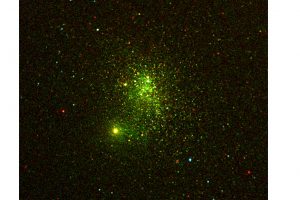Completed the Chandra/ACIS-I observations of the starburst cluster Westerlund 1 as part of the EWOCS (Extended Westerlund One Chandra Survey) project.

The amount of gas that is converted into stars by the star formation process is described by the star formation rate. For instance, in the Milky Way today between 0.7 and 1.5 solar masses of gas are converted into stars each year. However, this a mean value across our Galaxy, since locally clouds can start forming stars at higher rates than this value. The most extreme star forming regions are called “starburst regions”, and the resulting young stellar clusters “starburst clusters”.
Starburst events are common in the early Universe and in the interacting galaxies, where the gravitational interaction between the galaxies induces star formation rates tens or even hundreds times higher than that of the Milky Way. A typical example of such a phenomenon are the Antenna Galaxies.
In our Galaxy today only a handle of starburst clusters are known, while they were certainly more common in past epochs characterized by more intense star formation rates than today. The closest starburst region to the Sun is the young cluster Westerlund 1. With an initial mass of 52000 solar masses, and a current total mass between 20000 and 45000 solar masses, Westerlund 1 is thus the best target to study the products of star and planet formation processes, and the early stellar evolution in a starburst environment. Westerlund 1 is also characterized by an impressive population of massive stars, with some of the most massive stars known in the Galaxy, and several stars in transient evolutionary phases, which are very rare to be observed. The cluster also hosted at least one supernova explosion, as supported by the association with the cluster of the pulsar CXO J164710.20-455217, and it represents a typical environment where it is possible to form intermediate massive black holes, which have been observed to date only thanks to the emission of gravitational waves during coalescence events.
In order to unveil the properties of such an important cluster, the astronomer Mario Giuseppe Guarcello (INAF – Astronomical Observatory of Palermo) has recently obtained a long (1 million of seconds) observation with the NASA X-ray telescope Chandra, together with an infrared observation of 19 hours with the James Webb Space Telescope. These observations will be part of the project Extended Westerlund One Chandra Survey (EWOCS), in which 35 astronomers from 19 institutions are involved. Even if the team has started the data analysis only recently, it is clear that the project will produce important results, also thanks to the multidisciplinary skill of the team.
The long Chandra/ACIS-I observations (click here to visualize the entire image) of the cluster has been completed recently. In the image, the most energetic X-rays (photons with the energy between 2 and 7 keV) are colored in red, the less energetic (0.5-1.2 keV) in blue, while those with an intermediate energy in green. The energy of the observed X-ray photons depends on the physical processes and the temperature of the plasma responsible for the emission, together with the quantity of the intervening interstellar gas that absorbs the X-ray emission (the larger the interstellar absorption the more energetic the photons detected). In the image, the cluster with its dense core is in the center, while the pulsar is the bright source in the bottom left part of the image.
Mario Giuseppe Guarcello ( follow mguarce) ( youtube)
Subscribe the Youtube channel of the Astronomical Observatory of Palermo
